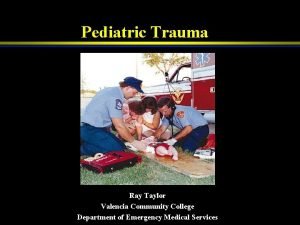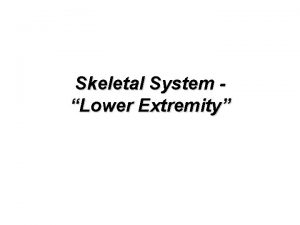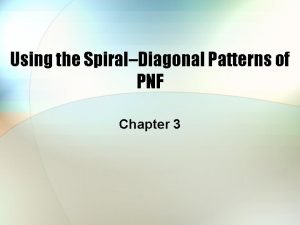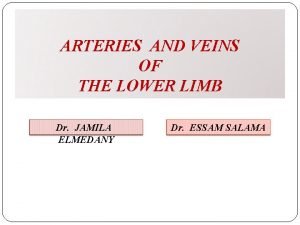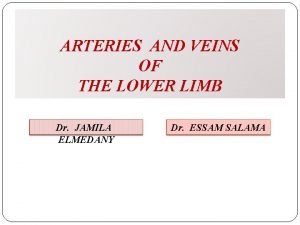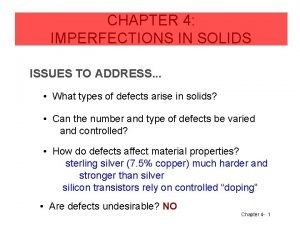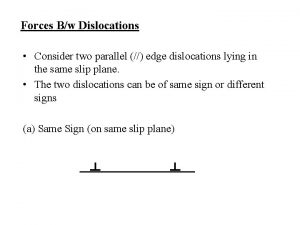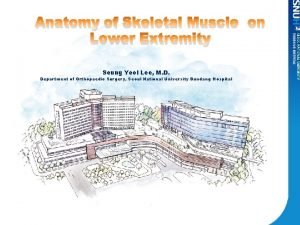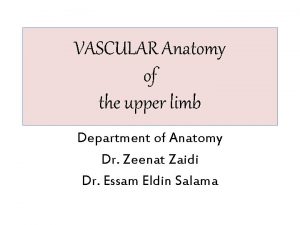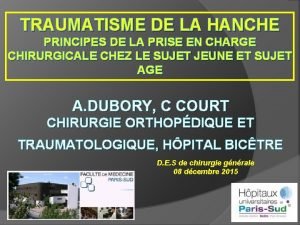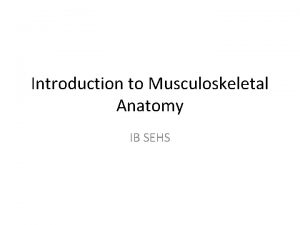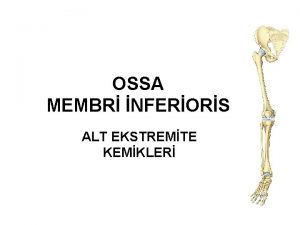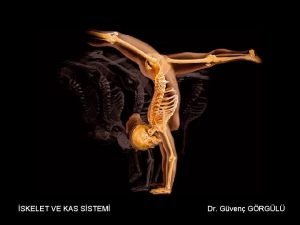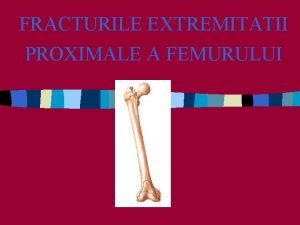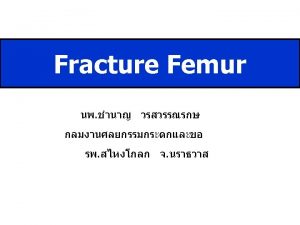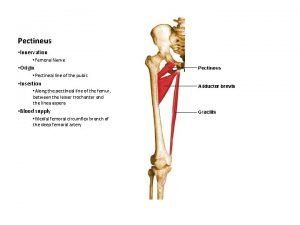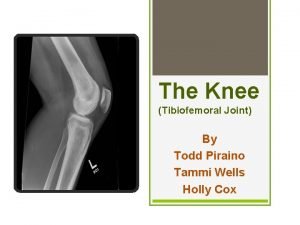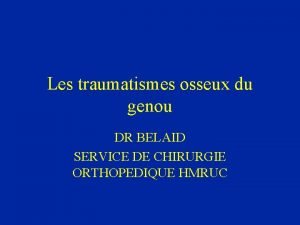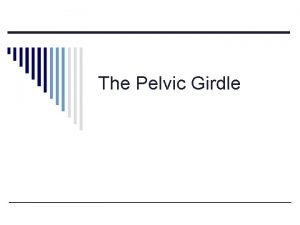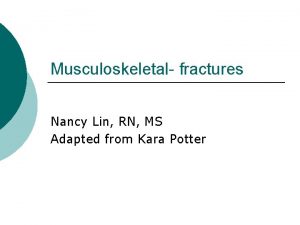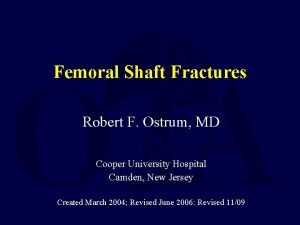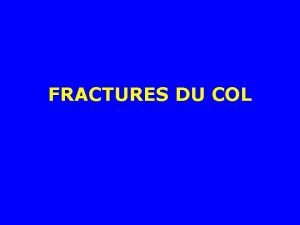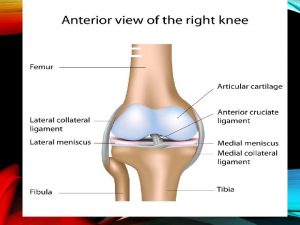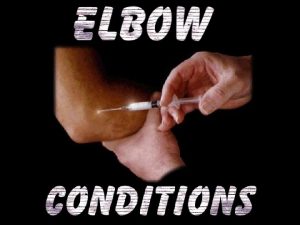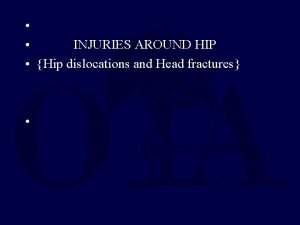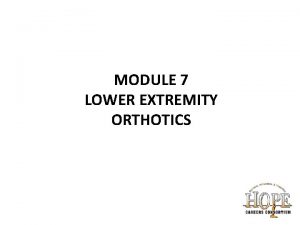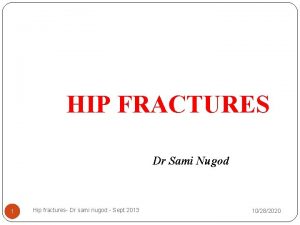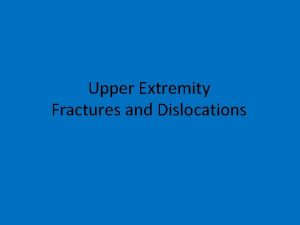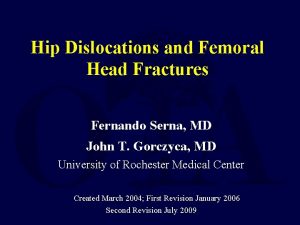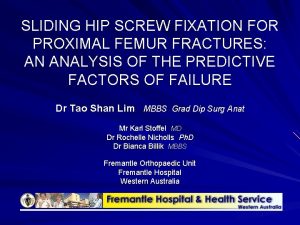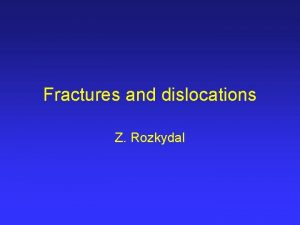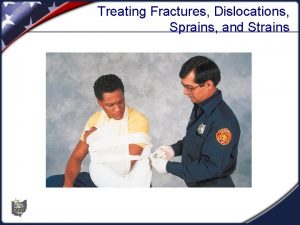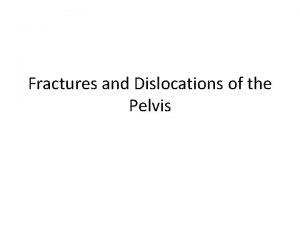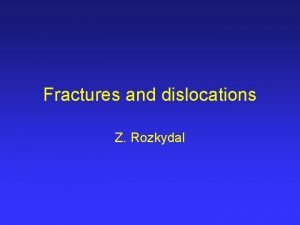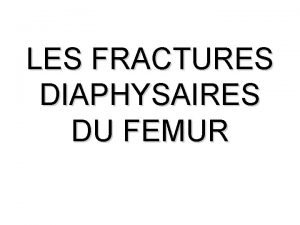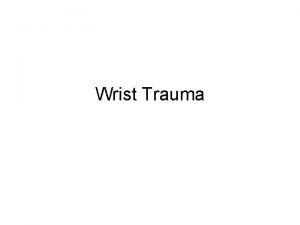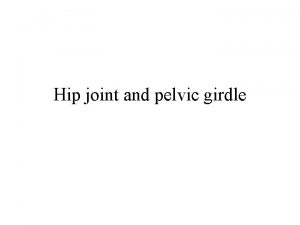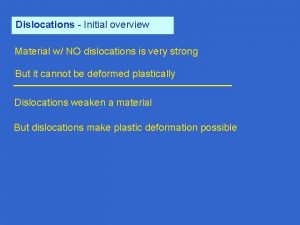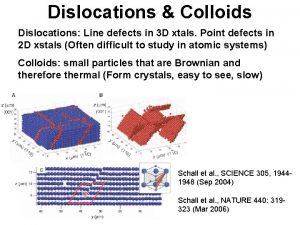Lower Extremity Trauma Hip Fractures Dislocations Femur Fractures













































- Slides: 45

Lower Extremity Trauma Hip Fractures / Dislocations Femur Fractures Patella Fractures Knee Dislocations Tibia Fractures Ankle Fractures

Hip Fractures Hip Dislocations Femoral Head Fractures Femoral Neck Fractures Intertrochanteric Fractures Subtrochanteric Fractures

Epidemiology 250, 000 Hip fractures annually Expected to double by 2050 At risk populations Elderly: poor balance & vision, osteoporosis, inactivity, medications, malnutrition Young: high energy trauma

Hip Dislocations Significant trauma, usually MVA Posterior: Hip flexion, Hip Internally Rotated & Adducted Anterior: Limb in Flexion, External Rotation, Abduction

Hip Dislocations Emergent Treatment: Closed Reduction Dislocated hip is an emergency Goal is to reduce risk of Avascular Necrosis and Degenrative Joint Disease Allows restoration of flow through occluded or compressed vessels Literature supports decreased AVN with earlier reduction Requires proper anesthesia Requires “team” (i. e. more than one person)

Hip Dislocations Emergent Treatment: Closed Reduction General anesthesia with muscle relaxation facilitates reduction, but is not necessary Conscious sedation is acceptable Attempts at reduction with inadequate analgesia/ sedation will cause unnecessary pain, cause muscle spasm, and make subsequent attempts at reduction more difficult

Hip Dislocations Emergent Treatment: Closed Reduction Allis Maneuver Assistant stabilizes pelvis with pressure on Ant. Sup. Iliac Spine Surgeon stands on stretcher and gently flexes hip to 90 deg, applies progressively increasing traction to the extremity with gentle adduction and internal rotation Reduction can often be seen and felt Insert Reduction Picture hip

Hip Dislocations Following Closed Reduction Check stability of hip to 90 deg flexion Repeat X Ray Pelvis AP Judet views of pelvis (if acetabulum fx) CT scan with thin cuts through acetabulum Remains of bony fragments within hip joint (indication for emergent OR trip to remove incarcerated fragment of bone)

Femoral Head Fractures Concurrent with hip dislocation due to shear injury

Femoral Head Fractures Pipkin Classification I: Fracture inferior to fovea II: Fracture superior to fovea III: Femoral head + acetabulum fracture IV: Femoral head + femoral neck fracture

Femoral Head Fractures Treatment Options Type I �Nonoperative: non-displaced �ORIF if displaced Type II: ORIF Type III: ORIF of both fractures Type IV: ORIF vs. hemiarthroplasty

Femoral Neck Fractures Garden Classification I Valgus impacted II Non-displaced III Complete: Partially Displaced IV Complete: Fully Displaced I II IV Functional Classification Stable (I/II) Unstable (III/IV)

Femoral Neck Fractures Treatment Options Non-operative �Very limited role �Activity modification �Skeletal traction Operative �ORIF �Hemiarthroplasty (Endoprosthesis) �Total Hip Replacement

Hemi ORIF THR

Femoral Neck Fractures Young Patients Urgent ORIF (<6 hrs) Elderly Patients ORIF possible (higher risk AVN, non-union, and failure of fixation) Hemiarthroplasty Total Hip Replacement

Intertrochanteric Hip Fx Intertrochanteric Femur Fracture Extra-capsular femoral neck To inferior border of the lesser trochanter

Intertrochanteric Hip Fx Intertrochanteric Femur Fracture Physical Findings: Shortened / ER Posture Obtain Xrays: AP Pelvis, Cross table lateral

Intertrochanteric Hip Fx Classification # of parts: Head/Neck, GT, LT, Shaft Stable �Resists medial & compressive Loads after fixation Unstable �Collapses into varus or shaft medializes despite anatomic reduction with fixation Reverse Obliquity

Intertrochanteric Hip Fx Stable Unstable Reverse Obliquity

Intertrochanteric Hip Fx Treatment Options Stable: Dynamic Hip Screw (2 -hole) Unstable/Reverse: Intra Medullary Recon Nail

Subtrochanteric Femur Fx Classification Located from LT to 5 cm distal into shaft Intact Piriformis Fossa? Treatment IM Nail Cephalomedullary IM Nail ORIF

Femoral Shaft Fx Type 0 - No comminution Type 1 - Insignificant butterfly fragment with transverse or short oblique fracture Type 2 - Large butterfly of less than 50% of the bony width, > 50% of cortex intact Type 3 - Larger butterfly leaving less than 50% of the cortex in contact Type 4 - Segmental comminution Winquist and Hansen 66 A, 1984

Femoral Shaft Fx Treatment Options IM Nail with locking screws ORIF with plate/screw construct External fixation Consider traction pin if prolonged delay to surgery

Distal Femur Fractures Distal Metaphyseal Fractures Look for intra-articular involvement Plain films CT

Distal Femur Fractures Treatment: Retrograde IM Nail ORIF open vs. MIPO Above depends on fracture type, bone quality, and fracture location

Knee Dislocations High association of injuries Ligamentous Injury �ACL, Posterolateral Corner �LCL, MCL Vascular Injury �Intimal tear vs. Disruption �Obtain ABI’s (+) Arteriogram �Vascular surgery consult with repair within 8 hrs Peroneal >> Tibial N. injury

Patella Fractures History MVA, fall onto knee, eccentric loading Physical Exam Ability to perform straight leg raise against gravity (ie, extensor mechanism still intact? ) Pain, swelling, contusions, lacerations and/or abrasions at the site of injury Palpable defect

Patella Fractures Radiographs AP/Lateral/Sunrise views Treatment ORIF if ext mechanism is incompetent Non-operative treatment with brace if ext mechanism remains intact

Tibia Fractures Proximal Tibia Fractures (Tibial Plateau) Tibial Shaft Fractures Distal Tibia Fractures (Tibial Pilon/Plafond)

Tibial Plateau Fractures MVA, fall from height, sporting injuries Mechanism and energy of injury plays a major role in determining orthopedic care Examine soft tissues, neurologic exam (peroneal N. ), vascular exam (esp with medial plateau injuries) Be aware for compartment syndrome Check for knee ligamentous instability

Tibial Plateau Fractures Xrays: AP/Lateral +/- traction films CT scan (after ex-fix if appropriate)

Schatzker Classification of Plateau Fxs Lower Energy Higher Energy

Tibial Plateau Fractures Treatment Spanning External Fixator may be appropriate for temporary stabilization and to allow for resolution of soft tissue injuries Insert blister Pics of ex-fix here

Tibial Plateau Fractures Treatment Definitive ORIF for patients with varus/valgus instability, >5 mm articular stepoff Non-operative in nondisplaced stable fractures or patients with poor surgical risks

Tibial Shaft Fractures Mechanism of Injury Can occur in lower energy, torsion type injury (e. g. , skiing) More common with higher energy direct force (e. g. , car bumper) Open fractures of the tibia are more common than in any other long bone

Tibial Shaft Fractures Open Tibia Fx Priorities – ABC’S – Associated Injuries – Tetanus – Antibiotics – Fixation

Tibial Shaft Fractures Management of Open Fx Soft Tissues ER: initial evaluation wound covered with sterile dressing and leg splinted, tetanus prophylaxis and appropriate antibiotics OR: Thorough I&D undertaken within 6 hours with serial debridements as warranted followed by definitive soft tissue cover

Tibial Shaft Fractures Definitive Soft Tissue Coverage – Proximal third tibia fractures can be covered with gastrocnemius rotation flap – Middle third tibia fractures can be covered with soleus rotation flap – Distal third fractures usually require free flap for coverage

Tibial Shaft Fractures Treatment Options IM Nail ORIF with Plates External Fixation Cast

Tibial Shaft Fractures Advantages of IM nailing Lower non-union rate Smaller incisions Earlier weightbearing and function Single surgery

Tibial Shaft Fractures IM nailing of distal and proximal fx Can be done but requires additional planning, special nails, and advanced techniques

Tibial Pilon Fractures involving distal tibia metaphysis and into the ankle joint Soft tissue management is key! Often occurs from fall from height or high energy injuries in MVA “Excellent” results are rare, “Fair to Good” is the norm outcome Multiple potential complications

Tibial Pilon Fractures Initial Evaluation Plain films, CT scan Spanning External Fixator Delayed Definitive Care to protect soft tissues and allow for soft tissue swelling to resolve

Tibial Pilon Fractures Treatment Goals Restore Articular Surface Minimize Soft Tissue Injury Establish Length Avoid Varus Collapse Treatment Options IM nail with limited ORIF External Fixator

Tibial Pilon Fractures Complications Mal or Non-union (Varus) Soft Tissue Complications Infection Potential Amputation
 Femur femur
Femur femur Spasticity vs tone
Spasticity vs tone Where is the pulse in foot
Where is the pulse in foot Skeletal system
Skeletal system Pnf spiral patterns are biplanar.
Pnf spiral patterns are biplanar. How to feel posterior tibial pulse
How to feel posterior tibial pulse Left lower extremity
Left lower extremity Dorsalis pedis artery pulse location
Dorsalis pedis artery pulse location Muscles of thigh cross section
Muscles of thigh cross section Dislocations in crystals
Dislocations in crystals Consider two edge dislocations of opposite sign
Consider two edge dislocations of opposite sign Poem about hip hop
Poem about hip hop Hip to the hippity hop
Hip to the hippity hop Mummy restraints diagram
Mummy restraints diagram Robert staron
Robert staron Pnf patterns upper extremity
Pnf patterns upper extremity Pink wristband meaning hospital
Pink wristband meaning hospital Okc ckc
Okc ckc Biomechanics of upper extremity
Biomechanics of upper extremity Lesser trochanter muscle
Lesser trochanter muscle Arteries of upper limb
Arteries of upper limb Lifting and moving patients
Lifting and moving patients Orrin franko md
Orrin franko md Classification de garden
Classification de garden Slender lateral bone of the leg
Slender lateral bone of the leg Difference between femur and humerus
Difference between femur and humerus Spring ligament
Spring ligament Promontorium hangi kemikte bulunur
Promontorium hangi kemikte bulunur Jugular notch
Jugular notch Fractura trohanteriana
Fractura trohanteriana Bohler braun frame
Bohler braun frame What nerves innervate the pectineus
What nerves innervate the pectineus Subtrochanteric femur fracture
Subtrochanteric femur fracture Greater trochanter
Greater trochanter Condyles of femur
Condyles of femur Fracture de trelat
Fracture de trelat Hip osteokinematics
Hip osteokinematics Skeletal traction femur
Skeletal traction femur Femur proximal übersetzung
Femur proximal übersetzung Bone tuberosity
Bone tuberosity Piriform fossa femur
Piriform fossa femur Hauteur utérine
Hauteur utérine Estribo de traccion esqueletica
Estribo de traccion esqueletica Clou de ender
Clou de ender Patellar tendinitis moi
Patellar tendinitis moi Osteosarcoma femur icd 10
Osteosarcoma femur icd 10
